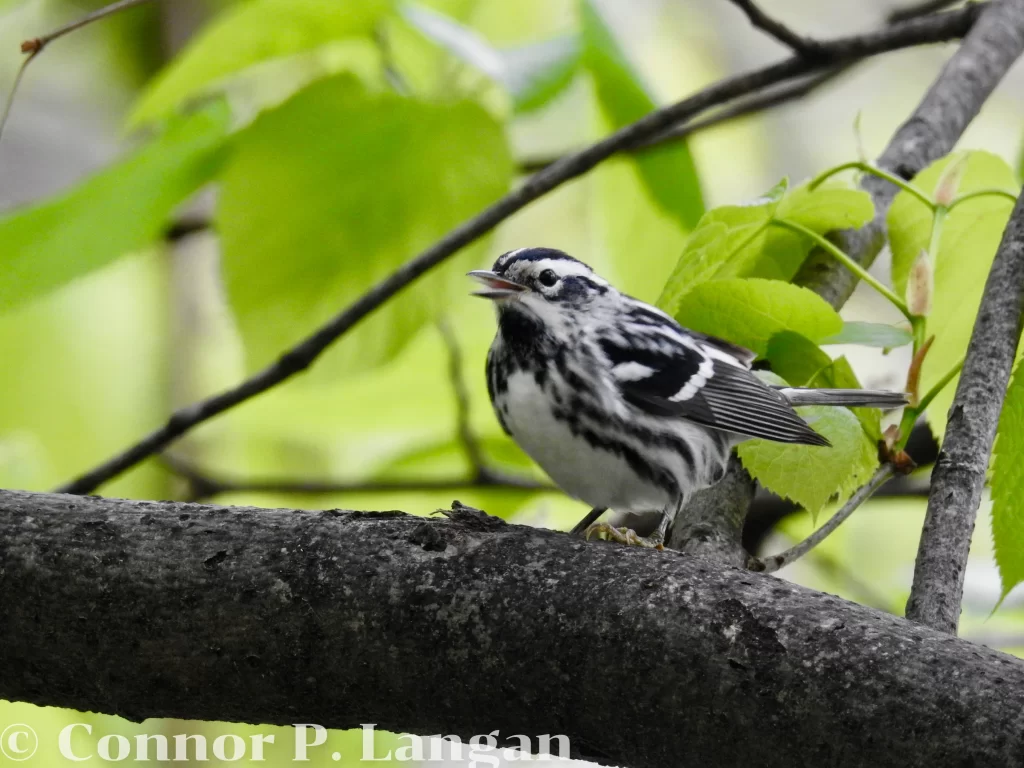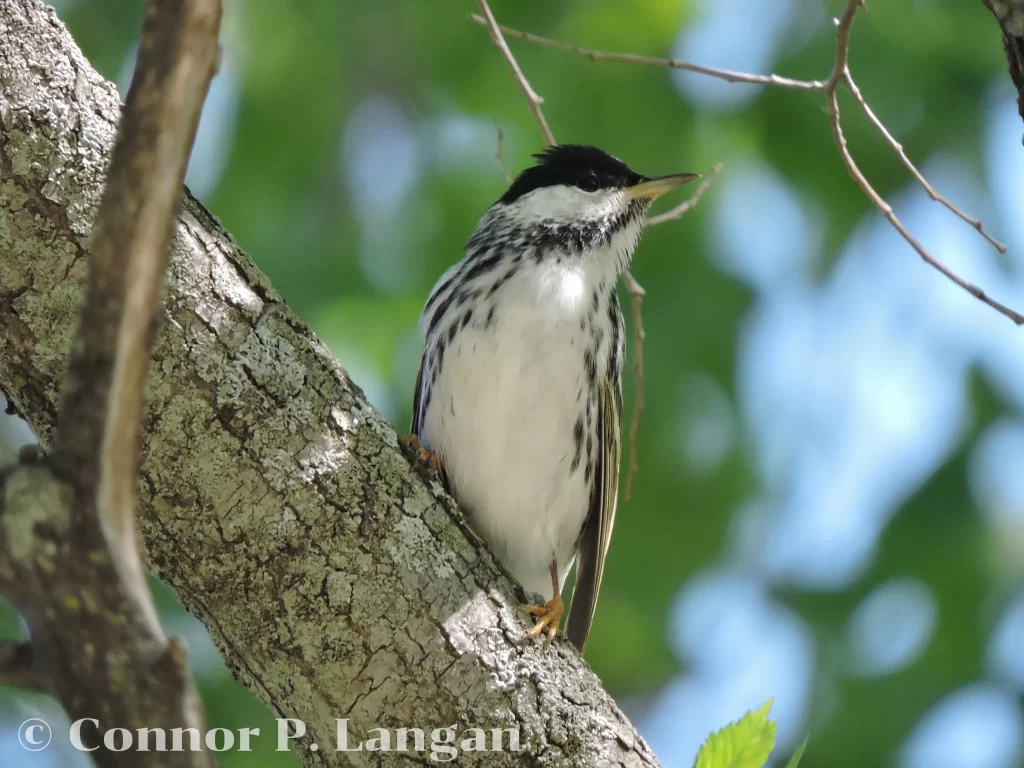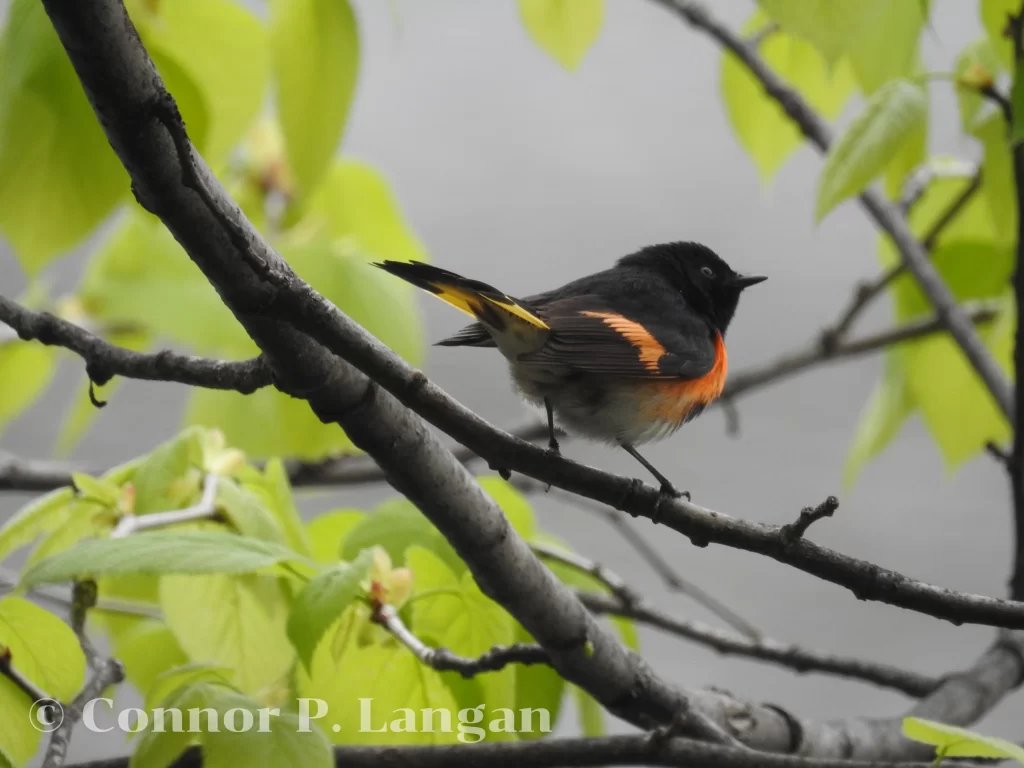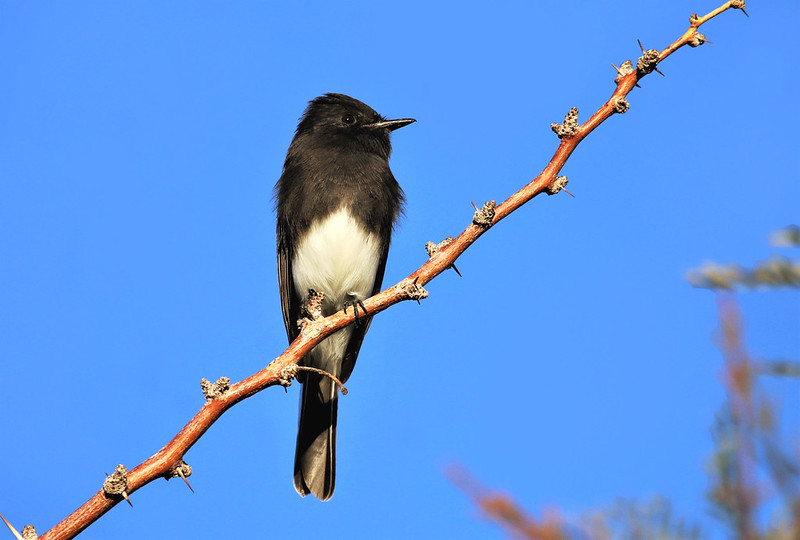Did you recently spot a small black bird with white belly coloration? North America is home to dozens of bird species that match the description of a small black bird with white belly coloration, so identifying the exact species can be challenging. Luckily, this guide will go over many of the common small black bird with white belly species that can be found in North America, but first:
Table of Contents
Why Are So Many Birds Black And White?
Countershading is one reason why there are so many species that are commonly described as a small black bird with white belly coloration.
Countershading is a method of predator avoidance that has evolved in many bird species. A bird with white belly and black back color has countershading.
Having a dark back is beneficial for small bird species because it allows them to be camouflaged from aerial predators. A white underside helps birds when they’re flying, as it makes them more difficult to spot for predators that are looking up at the sky.
Meanwhile, having a white belly helps aquatic bird species like penguins to be harder to detect when they’re swimming.
Now, let’s discover some small black and white bird species.
9 Small Black Bird With White Belly Species
Flycatchers
Most flycatchers in North America are some mix of green, gray, or yellow colors, but there are a couple of species that are good examples of a small black bird with white belly markings. Watch for these birds to fly to and from exposed perches as they feed on insects.
Eastern Kingbird (Tyrannus tyrannus)

About the size of an American Robin, Eastern Kingbirds are sizable flycatchers. The name of this species is a tad misleading, as these birds are found throughout the United States and Canada save for the American Southwest.
Eastern Kingbirds are monomorphic white and black bird species. They have slate gray backs that can appear black, but their heads are closer to a true black color. They are a good example of a small black bird with white chest coloration, as there is a stark difference between their backs and underside.
Eastern Kingbirds are easily found in open habitats with a good assortment of shrubs and small trees. They are extremely protective of their nests, so if you get too close, you may get dive-bombed.
Those hoping to attract this black and white small bird to their backyards will be disappointed to know that they do not eat from bird feeders or nest in birdhouses. However, they may use a bird bath or water source on a property for drinking and bathing.
Anyone with a property that has some open, grassy habitat with shrubs and small trees may attract this small black bird with white belly color.
Black Phoebe (Sayornis nigricans)

A Black Phoebe is a little black bird with white belly color. They are found throughout much of Mexico and into the American Southwest and California. They are perhaps the best match for a small black bird with white belly on this list.
Black Phoebes have a black head, neck, back, tail, chest, and black wings, but a white stomach sharply contrasts with the rest of their body. These small black and white birds pump their tails up and down constantly like any phoebe.
This tiny black and white bird is closely associated with water sources. Moreover, they love to catch insects that congregate around water, so look for Black Phoebes near lakes, ponds, streams, or rivers.
As is the case with any flycatcher, Black Phoebes are unlikely to visit a bird feeder unless it offers a tasty treat such as mealworms. This black and white small bird will not nest in birdhouses.
You will have a difficult time attracting Black Phoebes to your property–unless you have a water source nearby. Those fortunate enough to have a water source nearby may witness Black Phoebes constructing a nest under the eaves of a house.
Sparrows
North America is home to dozens of sparrow species. Many of these sparrows are not afraid to stop by your property as they search for a bite to eat. Though there are plenty of sparrows, only a few could be considered to be a small black bird with white belly color.
Dark-eyed Junco (Junco hyemalis)

Dark-eyed Juncos come in lots of different colors and patterns, and they rarely exceed 6 inches long. This small black and white bird is ubiquitous throughout North America.
There are around 15 subspecies of Dark-eyed Junco, and many of them appear to be a small black bird with white belly color. In reality, Dark-eyed Juncos are not truly black. Instead, these songbirds have a dark gray color that often covers their heads, necks, backs, chests, and wings. Many subspecies have white bellies.
Dark-eyed Juncos are known to be quite adaptable. These sparrows may be found in a wide array of habitats ranging from mountains to overgrown fields.
Dark-eyed Juncos will readily visit backyards due to their adaptable nature. This small black bird with white chest color is often one of the most common birds that will visit a bird feeder in the winter when they’re commonly found in Michigan and other Midwestern states.
You won’t have to do anything special to your yard to attract Dark-eyed Juncos. Those who own a little bit of land and a bird feeder will have a good chance of attracting this black and white small bird.
Harris’s Sparrow (Zonotrichia querula)

Harris’s Sparrows are small black and white birds that have a fairly restricted range. These 7-inch-long sparrows breed near the arctic tundra of Canada, while they spend their winters in the Great Plains states.
Harris’s Sparrows have a black face and neck, and black streaking extends down their flanks and backs. Birds that are not in breeding plumage will not have as much black, but they will still be small black birds with white belly color.
During winter and migration, Harris’s Sparrows can show up in a variety of early successional habitats. Anywhere with a decent amount of vegetative cover could host this small black and white bird, but they tend to avoid densely forested areas.
Backyard birders can attract Harris’s Sparrows to their yards by offering a variety of tasty treats like sunflower seeds. This species is more likely to forage below the feeder than actively feed out of a bird feeder.
If you have a yard with a little bit of space and a variety of shrubs, look for this little black bird with white belly color to visit.
Eastern Towhee (Pipilo erythrophthalmus)

The Eastern Towhee is a large sparrow that can exceed 8 inches in length. These birds are found east of the Great Plains and essentially confined to the United States. However, this small white and black bird does breed in a few of the eastern Canadian provinces.
Eastern Towhees are a match for a small black bird with white chest color, but they also have prominent orange flanks. Males and females are sexually dimorphic in their plumage. Males have black heads, backs, wings, and tails with a white stomach. Females do not have any black coloration.
Eastern Towhees are found in early successional habitats including forest edges, recently burned areas, and other locations that offer them plenty of small trees and shrubs.
They tend to be rather wary, but it will forage below bird feeders–especially if other birds are present. Offering a good mix of seeds—such as black oil sunflower seeds—will be enticing to Eastern Towhees.
Planting several species of shrubs and small trees will make a yard welcoming for a towhee.
Spotted Towhee (Pipilo maculatus)

Spotted Towhees are nearly identical in appearance and size to Eastern Towhees. These sizable sparrows are primarily found west of the Great Plains.
Spotted Towhees are sexually dimorphic like their Eastern Towhee counterparts. Female Spotted Towhees are darker than female Eastern Towhees, and they could themselves be considered small black birds with white bellies. Males are very similar to male Eastern Towhees, but both sexes have white spots on the wings and back.
Spotted Towhees are partial to open habitats with plenty of shrubs and lots of grasses and other vegetative growth along the ground.
This black and white small bird will visit backyards that have overgrown weedy vegetation or a bird feeder that offers their favorite seeds.
If you want Spotted Towhees to remain in your area, plant shrubs and allow areas of grass to grow without being cut or maintained in any way.
Warblers
North America is home to dozens of warbler species. Warblers are small, colorful birds, so a small black bird with white belly is typically not a good description of birds in this family. Nevertheless, a couple of species match this description.
Black-and-white Warbler (Mniotilta varia)

Rarely more than 5 inches in length, Black-and-white Warblers are a classic example of a small black bird with white stomach coloration. These little black birds with white bellies breed throughout much of eastern North America, while they winter in Mexico and Central America.
Both males and females have a mix of black and white streaking that covers most of their bodies. Males have more black coloration in their plumage, but the stomachs of both sexes are noticeably white.
Black-and-white Warblers are among the most common, recognizable warblers. These little black and white birds can be quickly identified by their habit of scaling up tree trunks much like nuthatches do.
This tiny black and white bird is unlikely to visit bird feeders, and they do not nest in birdhouses. Those who hope to attract them to a yard will need to offer a water source for them from which they can bathe and drink.
Black-and-white Warblers are not choosy about which habitats they frequent during migration – as long as your yard has some trees, you may attract one of these small black and white birds.
Blackpoll Warbler (Setophaga striata)

Blackpoll Warblers are a fairly large species of warbler, being 5.5 inches long. Blackpoll Warblers breed throughout the boreal forests of Canada and Alaska, while they winter in South America.
During the breeding season, the male appears to be a black bird with white chest color. However, a closer look will reveal black streaking across most of their bodies. The males of this tiny black and white bird have white stomachs. Meanwhile, females look a bit different, as they are a drab gray-brown color.
These tiny black birds with white belly color breed in coniferous forests, but they will stop over in whatever forested habitat they can find during migration.
Blackpoll Warblers are not a species that is going to eat from your bird feeder or nest in a birdhouse. If you want to have this bird with white belly and black back color in your yard, watch for them in the trees around your house.
If you strategically place a bird bath or small pond in your yard and surround it with trees and shrubs, you may see these black birds with white bellies bathing in it.
American Redstart (Setophaga ruticilla)

American Redstarts are common warblers that breed throughout North America save for the Southwest. They spend the winters in Mexico, Central America, and South America.
Male American Redstarts have black backs, wings, heads, chests, and tails with white stomachs. They are a good match for a small black bird with a white belly, but females are not. Female American Redstarts have gray heads with bodies that are white and yellow.
American Redstarts do not have strict habitat requirements for breeding, as they will breed in any open wooded area where deciduous trees are the primary tree type.
This small black and white bird will not eat from a bird feeder or nest in a birdhouse, but you could host a pair of breeding redstarts if you have anything larger than a small tract of trees on your land.
More adaptable than other warblers, these little black and white birds are among the most likely species of warbler to breed in your backyard.

